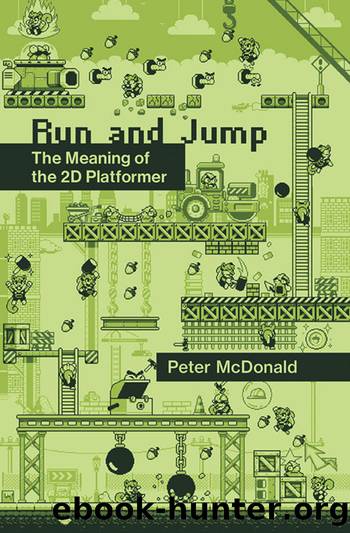Run and Jump by Peter D. McDonald

Author:Peter D. McDonald [McDonald, Peter]
Language: eng
Format: epub
Tags: platformer; genre studies; semiotics; structuralism; game feel; level design; close reading; Mario;
Publisher: MIT Press
Published: 2024-01-17T00:00:00+00:00
Figure 3.1
Mega Man attacking a Metall C-15, or Met, in Mega Man X (1993).
Why should such a power be vested in enemies rather than another game element? As chapter 1 argues, action on a 2D plane is the language of platformers. Movement, force, and violence become signs that an object exists in the same world with the player. Of all the objects that exist in game space, enemies occupy it in a uniquely reciprocal fashion. Enemies can touch the player, and she can collide with them. Enemies can hurt the player, and she can destroy them. The player is passive in the same way an enemy is passive and active in the same way it is active. All of these mirrorings differentiate enemies from the brute environment, from coins and switches, from friendly characters and the user interface. The floor and walls, for example, stop the player and exert force on her but cannot be influenced. Without a full simulation of Newtonian physics, a levelâs boundaries lack the equal and opposite reaction of inertia and become simply inert. A nonplayer character like Dr. Light speaks to Mega Man, but the player can never respond in kind. Other characters might sell an item or save the game, but the player rarely reciprocates these interactions. Even as bodies in space, these friendly characters exist on another plane and do not impede or touch the player. Rather than offering an obstacle, the avatar simply passes through them as if they were ghosts. The platformerâs generic emphasis on movement thus makes physical force into a medium of communication and exchange. The violent confrontations between player and enemy are an outgrowth of that framing. However we understand the meaning of violence, it demonstrates a prior communion through shared vulnerability.4
Game mechanics are a language that the player learns to speak, but without enemies, the player is stuck in a monologue of movement and survival. Through the reciprocal relations of speed and force, enemies become interlocutors in a conversation with the player where combat expresses a conflict over the proper uses of space.5 Some enemies share the playerâs vocabulary and grammar of movement but are guided by an entirely different worldview. They walk endlessly back and forth across a platform or hold fast to a single position within a level. Other enemies introduce new mechanics into the language of motion by flying where Mega Man must walk or attacking with unprecedented speed. In individual encounters, the player learns about the possible differences and variations that the gameâs space allows. At the same time, fighting through hordes of robots reveals how these individual encounters belong within a complex system.
We previously considered how individual action signs such as jumping belong within a system of mechanics and that other verbs also shape the meaning of a jump. However, we did not examine the nature of that systematicity itself, and it is a crucial concept for structuralism. For thinkers like Ferdinand de Saussure, there is a fundamental difference between speech and language.
Download
This site does not store any files on its server. We only index and link to content provided by other sites. Please contact the content providers to delete copyright contents if any and email us, we'll remove relevant links or contents immediately.
Dawn of the New Everything by Jaron Lanier(2441)
The Infinite Retina by Robert Scoble Irena Cronin(2257)
The Art of Doom by Bethesda(1777)
Significant Zero by Walt Williams(1632)
Creative Character Design by Bryan Tillman(1562)
The Ultimate Roblox Book by David Jagneaux(1427)
World of Warcraft Chronicle Volume 3 by Blizzard Entertainment(1372)
Dawn of the New Everything: Encounters with Reality and Virtual Reality by Jaron Lanier(1332)
Art Of Atari by Tim Lapetino(1329)
Pillars of Eternity Guidebook by Obsidian Entertainment(1271)
1628927445Game by Unknown(1250)
Unity 2018 By Example by Alan Thorn(1211)
Learning D by 2015(1210)
Unreal Engine 4 Virtual Reality Projects by Kevin Mack(1205)
The Ultimate Player's Guide to Minecraft by Stephen O'Brien(1183)
Unreal Engine Virtual Reality Quick Start Guide by Jessica Plowman(1178)
Flynn's Log 1 by Stone Marshall(1162)
Godot 4 Game Development Cookbook by Jeff Johnson(1140)
Road Games by Road Games(1131)
